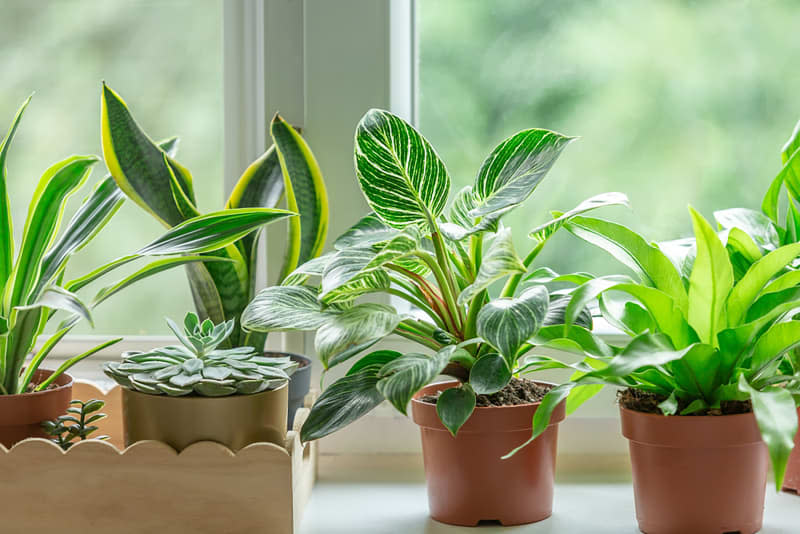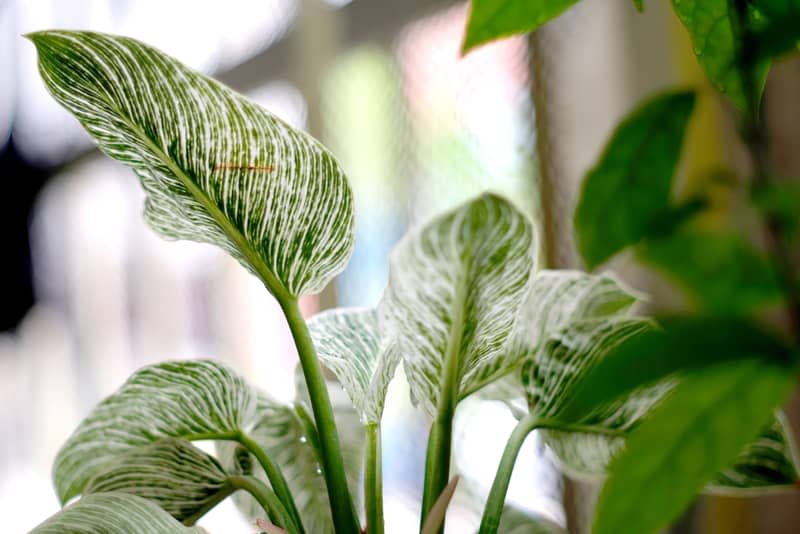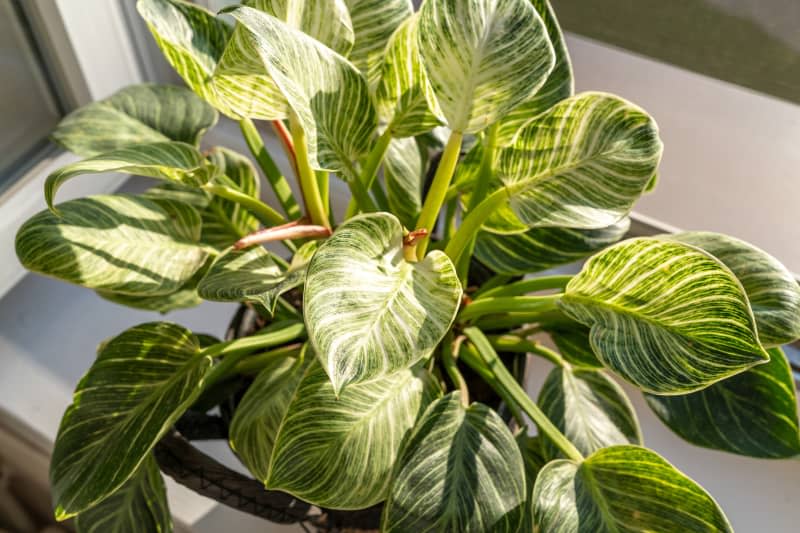Don’t Be Scared by This Houseplant — It Only *Looks* High-Maintenance

A few years ago, we called the philodendron Birkin plant one of the hottest up-and-coming houseplants of 2020 — and back then, it was still relatively difficult to find. But now, the philodendron Birkin is one of those popular plants that traversed the trajectory from rare and coveted plant to being readily available at grocery stores and home centers due to the rise in demand.
About a year ago, a philodendron Birkin caught my eye in the grocery store and I couldn’t help bringing it home with me. (I really can’t be trusted anywhere where there are plants.) It has been a wonderfully low-maintenance plant. The most work I ever have to do with it is regularly dust its beautiful leaves.
Most people love philodendron Birkin because of its lovely variegated foliage. Thin veins of white or yellow (and sometimes pink!) trace its leaves. These variegations, in fact, are the reason Birkins came into being, but they’re tenuous; the amount of light exposure (via natural lighting or grow lights) can cause them to become more striking or even disappear altogether.
Even though the plant is considered an easy-care choice (and it is), the philodendron Birkin rewards conscientious owners with striking foliage carried by the plant in a perky, lush upright habit. To make matters even better, straightforward propagation makes it easy to share this much-loved plant with friends. Here’s how to care for one.

What Is a Philodendron Birkin?
The philodendron Birkin is not found in the wild. It came to be when the philodendron Rojo Congo mutated, which is known as a spontaneous chimeric mutation. The resulting plant was propagated until the variety became stable and known as the philodendron Birkin.
The philodendron Birkin boasts dark green, glossy leaves that are usually laced with white or yellow pinstripes, but because of the plant’s origins, the Birkin can also express fully red or slightly pink leaf variations. In addition, the plant’s stripes might not appear until the plants are mature.
Depending on lighting conditions and also due to the fact that the Birkin is a mutation and therefore somewhat unstable, the variegation that the Birkin is known and loved for can fluctuate.
While philodendrons come in many growth habits, the philodendron Birkin has a sturdy, upright growth on a strong main stem. However, as the plants get older and taller, they may benefit from a support pole if they get top-heavy.
Like all philodendrons, philodendron Birkin are considered low-maintenance plants, which probably accounts in large part for their popularity.
While they’re not finicky, the large leaves of philodendron Birkins do collect dust. The plants benefit from regular leaf-wiping, which not only cleans them and helps them thrive, but also promotes variegation (because clean leaves absorb more light).
Is a Philodendron Birkin Toxic?
Yes, the philodendron Birkin is toxic to both humans and pets. Vladan Nikolic of Mr. Houseplant explains that “the sap and juice of Birkin plants contain calcium oxalate crystals.” In humans, these crystals “can irritate the oral cavity and can also cause throat swelling and breathing difficulties.” In dogs and cats, the philodendron Birkin can cause “irritation of the mouth and tongue and provoke drooling, vomiting, or difficulty swallowing.”
How to Fertilize a Philodendron Birkin
General fertilizing advice applies to the philodendron Birkin as well. Only fertilize the plant when it is actively growing. This often means fertilizing in spring and summer and skipping fertilization in fall and winter, but just keep an eye on your plant. It’s important not to fertilize when the plant is dormant, Nikolic points out, because “if your plant isn’t actively growing, excess minerals from the fertilizer will accumulate in the soil and can burn the roots.”
Keep in mind that according to Nikolic, if you repot your Bikin once a year, the fresh soil should provide enough nutrients to your plant that you won’t need fertilizer.

What Kind of Light Does My Philodendron Birkin Need?
As with so much of plant care, light requirements for the philodendron Birkin are a balancing act. Plant enthusiast Emily Auffrey, whose NYC apartment is a foliage-filled oasis, says that the philodendron Birkin prefers “low to bright indirect light.”
Auffrey further points out that “the more sun it receives, the more white variegation it will have” but also cautions that “direct light will most likely turn the leaves’ edges brown.” Lack of light, on the other hand, will cause variegation to fade — this is not a houseplant that will look its best in low light conditions.
Nikolic also suggests “medium” light, and specifies that the philodendron Birkin “needs a minimum of 1,000 lux (100 FC) of medium indirect light, but to optimize your plant growth, strive for at least 2,500 lux (250 FC).”
Note: Lux and “FC,” which stands for “foot-candle,” are both measurements of light intensity. Full sun comes in at 10,000 FC and 32,000 to 100,000 lux; overcast daylight is about 100 FC and 1,000 lux.
Nikolic says that Birkins can tolerate two to three hours of direct light but that it should occur only early in the morning or late afternoon.
Paying attention to what’s happening with the variegation on your Birkin can tell you a lot about whether you need to adjust its light exposure. If the variegation is fading, it probably needs more light.
How Do I Water a Philodendron Birkin?
When it comes to watering your philodendron Birkin, Auffrey recommends a general guideline of watering once a week in the summer and every couple weeks in the winter, but says that watering frequency also depends on how much light the plant is getting. Philodendron Birkins don’t like to be overwatered, and Auffrey cautions, “The soil should dry out almost completely before you water again.”
In keeping with the philodendron Birkin’s dislike of overly moist soil, Nikolic points out that it’s important for your Birkin’s pot to have drainage holes.
Like other philodendrons, Birkins enjoy humidity, but don’t usually require additional efforts to increase humidity.
How Do I Propagate a Philodendron Birkin?
Philodendron Birkins are super easy to propagate.
To propagate, simply make a cutting with sterile scissors that contains one or more leaf nodes a few leaves above them. Remove the bottom two leaves and place the cutting in water until roots appear. Make sure you keep the water fresh. Once the roots are a couple inches long, you can transplant the cutting into soil.

How to Prune a Philodendron Birkin
Pruning is not required for a philodendron Birkin, so you can stick to just cutting off dead or damaged leaves and any diseased portions of the plant. “A really great thing about most philodendrons,” Auffrey shares, “is that if a leaf unfurls and it’s damaged or if a leaf becomes damaged you can cut just the leaf off and a new leaf is still able to grow in.”
The only other time you may want to prune your philodendron Birkin is if you want it to branch out, in which case you can just cut off the top of the stem and the plant will branch out from there.
Common Problems with Philodendron Birkins (and How to Fix Them)
In addition to the fluctuations in the leaves’ variegation discussed above, which can be solved by adjusting light exposure, philodendron Birkins can experience some other types of distress. Here a few common philodendron Birkin problems — and how to fix them.
Pests
Philodendron Birkins are generally pest-free, according to Nikolic, who points out that plants that receive proper care are less susceptible to pests. If you do find mealy bugs, spider mites, or aphids early on, they are usually pretty easy to hand-pick. Otherwise, a good spraying down can often solve the problem.
Fungal Diseases
Fungal diseases in philodendron Birkins can cause brown lesions on the leaves, yellow or wilting leaves, mushy roots, or white cotton-like masses. The best ways to prevent fungal diseases are to ensure that your potting medium is sterile, and that your soil is well-draining, porous, and non-compacted.
Brown Tips
Brown tips on the philodendron Birkin are usually caused by underwatering, too much fertilizer, or low humidity. Adjust as necessary.
Curling Leaves
Curling leaves are a sign of a thirsty, underwatered philodendron Birkin.
Yellow leaves
In philodendron Birkins, yellow leaves can be caused by either over- or under-watering, normal aging of leaves, or pests. If the pests are addressed and you’re making sure to water only when the soil is dry, it’s safe to assume that yellow leaves are due to natural leaf death.

